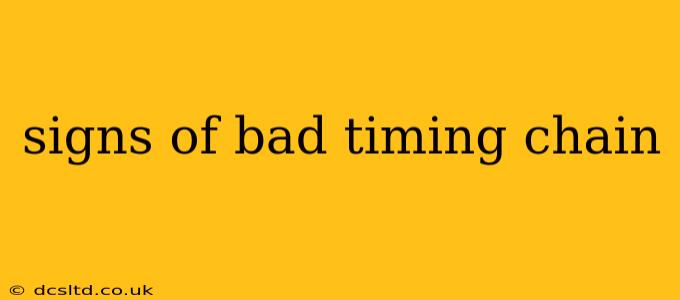A timing chain is a crucial component in your vehicle's engine, responsible for synchronizing the crankshaft and camshaft rotation. When this vital link falters, it can lead to significant engine damage. Recognizing the signs of a failing timing chain early can save you from costly repairs. This guide will help you identify potential problems and understand when it's time to seek professional help.
What is a Timing Chain and Why is it Important?
Before diving into the warning signs, let's briefly understand the timing chain's function. Unlike a timing belt, which is made of rubber and requires periodic replacement, a timing chain is a metal chain designed for longer lifespan. Its job is to precisely synchronize the rotation of the crankshaft (which converts piston movement into rotational power) and the camshaft (which controls the valves that regulate the air-fuel mixture in the engine cylinders). If the timing is off, even slightly, it can cause catastrophic engine damage.
Common Signs of a Bad Timing Chain
Several symptoms indicate potential problems with your timing chain. These can range from subtle noises to more severe engine malfunctions.
1. Loud Knocking or Rattling Noise from the Engine
One of the most common early signs is a noticeable knocking or rattling sound emanating from the engine. This sound is often more pronounced at startup or when the engine is cold. The noise is caused by the chain becoming loose or worn, causing it to slap against the timing chain cover or other engine components. The sound might vary in intensity and frequency depending on engine speed.
2. Engine Misfires or Rough Running
A worn or stretched timing chain can affect the precise timing of the valves opening and closing. This misalignment can lead to inconsistent fuel delivery and ignition, resulting in engine misfires. You might notice the engine running rough, hesitating during acceleration, or experiencing a loss of power.
3. Check Engine Light Illuminates
Your vehicle's check engine light is a crucial indicator of potential problems. While it doesn't specifically pinpoint a timing chain issue, it can alert you to problems that could be related, like misfires or other engine performance issues that often accompany a failing timing chain. It's vital to get a diagnostic scan to determine the specific cause of the light's activation.
4. Engine Performance Issues
Beyond misfires and rough running, you may experience a noticeable decrease in engine power or performance. The vehicle might struggle to accelerate or maintain speed, especially under load. This is because the inaccurate valve timing is hindering the engine's efficiency.
5. Metal Shavings in the Engine Oil
This is a more serious sign and indicates significant wear on the timing chain. If you notice metal shavings in your engine oil during an oil change, it's a strong indication of serious internal engine damage, likely requiring immediate attention.
How Often Should a Timing Chain Be Replaced?
Unlike timing belts, timing chains are designed to last the lifespan of the vehicle in many cases. However, this doesn't mean they're indestructible. Wear and tear can occur over time, especially under harsh driving conditions or with inadequate maintenance. Consult your vehicle's maintenance schedule for recommended replacement intervals, as they can vary significantly based on make, model, and engine type.
What Happens if You Ignore a Bad Timing Chain?
Ignoring a bad timing chain can lead to severe engine damage. The most catastrophic outcome is a broken timing chain, which can cause the valves to collide with the pistons. This results in bent valves, damaged pistons, and potentially a complete engine failure, requiring extensive and costly repairs or even engine replacement.
FAQs Related to Timing Chain Issues
What are the sounds of a failing timing chain?
A failing timing chain often produces a rattling, knocking, or ticking sound, especially when the engine is cold or at startup. The sound might vary in intensity and pitch depending on the engine speed.
How much does it cost to replace a timing chain?
The cost to replace a timing chain varies significantly depending on the vehicle make and model, labor rates, and the extent of the required repairs. It’s usually a more expensive repair than a timing belt replacement due to the increased complexity of the job.
Can you drive with a bad timing chain?
While you might be able to drive with a slightly worn timing chain for a short period, it's highly risky. Continued driving with a significantly damaged chain could lead to catastrophic engine failure.
How long can a timing chain last?
The lifespan of a timing chain varies greatly depending on vehicle type, driving conditions, and maintenance. While some chains can last the life of the vehicle, others may require replacement after a significant number of miles or years.
What are the first signs of a stretched timing chain?
Early signs of a stretched timing chain often include a rattling noise from the engine, particularly during startup or when cold, and minor engine performance issues such as rough running or slight hesitation.
This comprehensive guide provides insights into the symptoms and potential consequences of a failing timing chain. Remember, addressing the problem early can prevent significant engine damage and costly repairs. If you suspect a problem with your timing chain, consult a qualified mechanic immediately.
